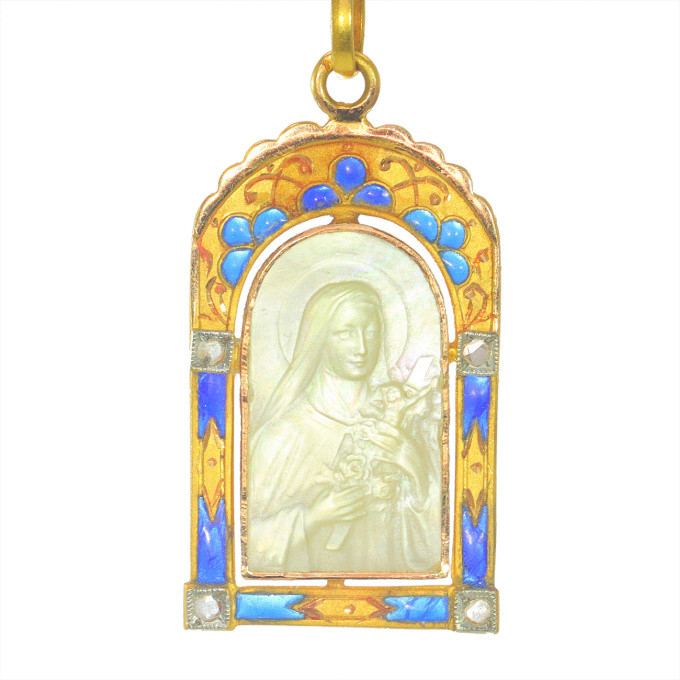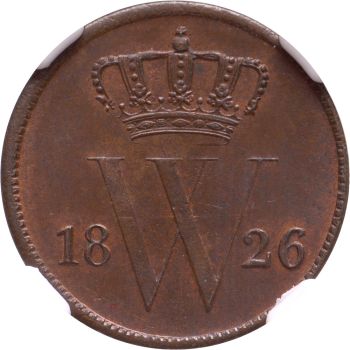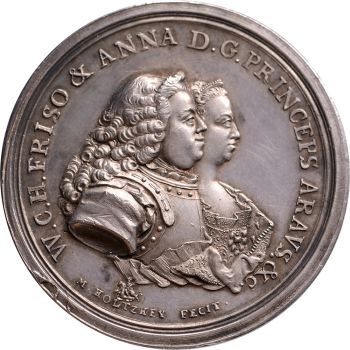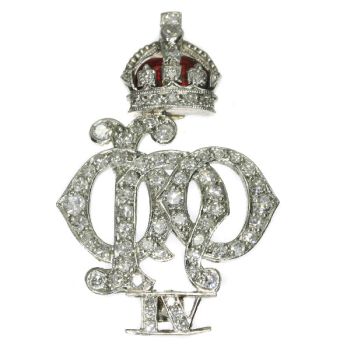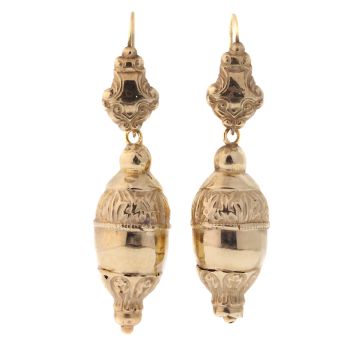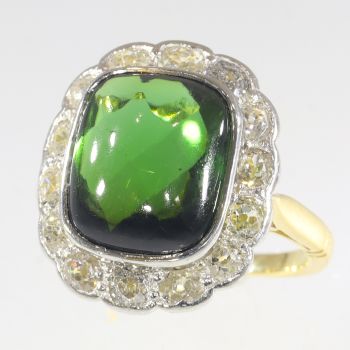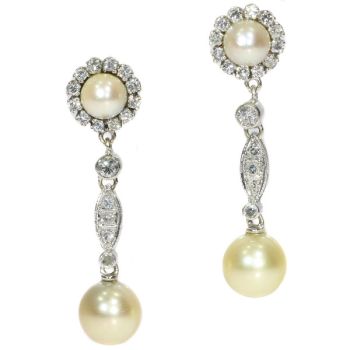Vintage antique 18K gold mother-of-pearl medal Mother Mary with the miracle of the roses - set with 1910
Artista Sconosciuto
€ 825
Adin Fine Antique Jewellery
- A proposito di opere d'arte
Antique jewelry object group
pendant
Condition
very good condition
more info on our condition scale
Country of origin
unknown
Style
something between the Late-Victorian and Belle Epoque style - Victorian decorative arts refers to the style of decorative arts during the Victorian era. The Victorian era is known for its eclectic revival and interpretation of historic styles and the introduction of cross-cultural influences from the middle east and Asia in furniture, fittings, and Interior decoration.
Victorian design is widely viewed as having indulged in a regrettable excess of ornament.
And the Belle Époque style (Belle Époque is French for "Beautiful Era") was a period in European social history that began during the late 19th century and lasted until World War I. Occurring during the time of the French Third Republic and the German Empire, the "Belle Époque" was named in retrospect, when it began to be considered a "golden age" the major powers of Europe, new technologies improved lives and the commercial arts adapted Renaissance and eighteenth-century styles to modern forms. In the newly rich United States, emerging from the Panic of 1873, the comparable epoch was dubbed the Gilded Age. In the United Kingdom, this epoch overlaps the end of what is called the Victorian Era there and the period named the Edwardian Era.
See also: late-Victorian
more info on styles
Style specifics
The Late or Aesthetic Victorian Period - Experts divide the reign of Queen Victoria, also called The Victorian era (1837-1901) into three periods of about twenty years each; The Romantic Victorian Period (1837 - 1860), The Grand Victorian Period (1860 - 1880), and the Late or Aesthetic Victorian Period (1880 - 1901).
We consider this to be of The Late or Aesthetic Victorian Period.
Jewelry of this period is changing back from heavy to more smaller, romantic pieces with often whimsical motifs. Jewelers using diamonds and bright gemstones in elaborated and fine feminine pieces.
Period
ca. 1910
Events & facts of this era, poetry of this era, fashion of this era.
Source of inspiration
Christianity
Theme
Mother Mary and the Miracle of the Roses
Material
18K yellow gold (touchstone tested)
more info on precious metals
Technique
Plique a jour which is a French term for a technique of decoration in enamelling by which the design is outlined in metal and filled in with one or variously colored transparent enamels but with no backing behind the enamel, so that the effect is similar to that of a stained-glass window. This effect is clearly visible at one of the pictures we took with lighting from the back.
Extra information
The Rose the ultimate symbol of love which has many prophecies, legends and fairy tales made about it.
A rose that blooms in autumn can mean a marriage. And you must remember the fairy tale of Sleeping Beauty. The bad queen pricked the beautiful, young princess with a thorn from a rose. She slept 100 years and a beautiful, young prince woke her up with a kiss. They married and they lived happily ever after. There exists a legend about how the rose got her thorns. The rose grew originally in the Garden of Eden and had no thorns. After the fall the rose got her thorns to remind people of their sin. Her beauty might been kept as memory of Paradise.
In the antiquity Eros, the Greek God of Love, was represented as a fresh and rosy (color of roses), lively and cheerful boy with goldish hair (like the stamens). The arrows were like the thorns and his wings were like the petals of the rose. In beauty, shape and scent, the rose is outstanding and hence has become the most commonly used floral symbol in the West. Roses have symbolical meanings in classic and Christian art. For example Venus was associated with roses, symbolizing love and beauty, whereas Virgin Mary sometimes was called a « rose without thorns » because of her purity.
Diamonds
Four senailles. A senaille is a simplified rose cut diamond, a small diamond chip with perhaps a few polished facets. We do not have the weight of these diamonds which is normal in our trade when it comes to senailles.
All diamonds we offer are screened by the I.J.G.C. for whether they are natural or synthetic, and all diamonds in this jewel are 100% guaranteed to be natural.
Precious stones
One plate of mother-of-pearl
Birthstones
Diamond is the birthstone (or month stone) for April.
more info on birthstones
Hallmarks
Illegible remains.
more info on hallmarks
Dimensions
2,66 cm (1,05 inch) x 1,25 cm (0,49 inch)
see picture with a ruler in millimeters and inches
Weight
1,30 gram (0,84 dwt)
Adin Reference Nº
23191-0417
Copyright photography
Adin, fine antique jewellery
Additional information
our latest acquisitions
jewelry glossary
wall of fame
visit us in Antwerp
subscribe to our mailinglist
- A proposito di opere artista
Può succedere che un artista o un creatore sia sconosciuto.
Alcune opere non sono determinate da chi sono state realizzate o sono state realizzate da (un gruppo di) artigiani. Esempi sono statue dell'antichità, mobili, specchi o firme non chiare o leggibili ma anche alcune opere non sono affatto firmate.
Inoltre puoi trovare la seguente descrizione:
•"Attribuito a …." A loro avviso probabilmente opera dell'artista, almeno in parte
•“Studio di ….” o “Officina di” A loro avviso un'opera eseguita nello studio o nella bottega dell'artista, eventualmente sotto la sua supervisione
•“Cerchio di…” A loro avviso un'opera del periodo dell'artista che mostra la sua influenza, strettamente legata all'artista ma non necessariamente al suo allievo
•"Stile di..." o "Seguace di..." A loro avviso un'opera eseguita nello stile dell'artista ma non necessariamente da un allievo; può essere contemporaneo o quasi contemporaneo
•“Modalità di…” A loro avviso un'opera nello stile dell'artista ma di epoca successiva
•"Dopo …." A loro avviso una copia (di qualsiasi data) di un'opera dell'artista
•“Firmato…”, “Datato…” o “Iscritto” A loro avviso l'opera è stata firmata/datata/inscritta dall'artista. L'aggiunta di un punto interrogativo indica un elemento di dubbio
•"Con firma....", "Con data...", "Con iscrizione..." o “Riporta firma/data/iscrizione” a loro avviso la firma/data/iscrizione è stata aggiunta da qualcuno diverso dall'artista
Sei interessato ad acquistare questa opera d'arte?
Related artworks
Artista Sconosciuto
A Surinam-themed Amsterdam long-case clock1746 - 1756
Prezzo su richiestaZebregs & Röell - Fine Art - Antiques
 A cura di
A cura diGallerease Magazine
1 - 4 / 12- 1 - 4 / 12

